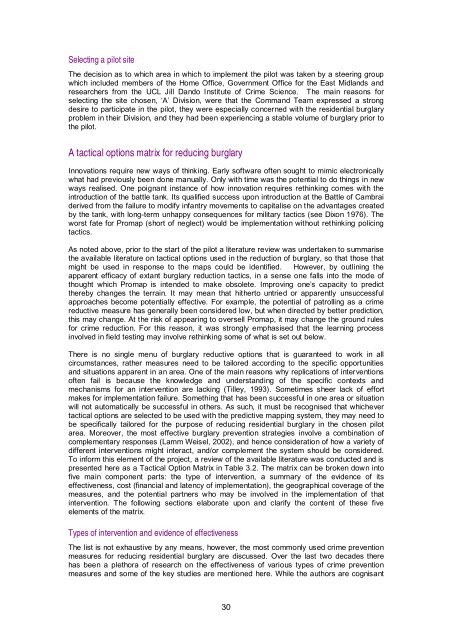Prospective crime mapping in operational context Final report
Prospective crime mapping in operational context Final report
Prospective crime mapping in operational context Final report
- No tags were found...
Create successful ePaper yourself
Turn your PDF publications into a flip-book with our unique Google optimized e-Paper software.
Select<strong>in</strong>g a pilot siteThe decision as to which area <strong>in</strong> which to implement the pilot was taken by a steer<strong>in</strong>g groupwhich <strong>in</strong>cluded members of the Home Office, Government Office for the East Midlands andresearchers from the UCL Jill Dando Institute of Crime Science. The ma<strong>in</strong> reasons forselect<strong>in</strong>g the site chosen, ‘A’ Division, were that the Command Team expressed a strongdesire to participate <strong>in</strong> the pilot, they were especially concerned with the residential burglaryproblem <strong>in</strong> their Division, and they had been experienc<strong>in</strong>g a stable volume of burglary prior tothe pilot.A tactical options matrix for reduc<strong>in</strong>g burglaryInnovations require new ways of th<strong>in</strong>k<strong>in</strong>g. Early software often sought to mimic electronicallywhat had previously been done manually. Only with time was the potential to do th<strong>in</strong>gs <strong>in</strong> newways realised. One poignant <strong>in</strong>stance of how <strong>in</strong>novation requires reth<strong>in</strong>k<strong>in</strong>g comes with the<strong>in</strong>troduction of the battle tank. Its qualified success upon <strong>in</strong>troduction at the Battle of Cambraiderived from the failure to modify <strong>in</strong>fantry movements to capitalise on the advantages createdby the tank, with long-term unhappy consequences for military tactics (see Dixon 1976). Theworst fate for Promap (short of neglect) would be implementation without reth<strong>in</strong>k<strong>in</strong>g polic<strong>in</strong>gtactics.As noted above, prior to the start of the pilot a literature review was undertaken to summarisethe available literature on tactical options used <strong>in</strong> the reduction of burglary, so that those thatmight be used <strong>in</strong> response to the maps could be identified. However, by outl<strong>in</strong><strong>in</strong>g theapparent efficacy of extant burglary reduction tactics, <strong>in</strong> a sense one falls <strong>in</strong>to the mode ofthought which Promap is <strong>in</strong>tended to make obsolete. Improv<strong>in</strong>g one’s capacity to predictthereby changes the terra<strong>in</strong>. It may mean that hitherto untried or apparently unsuccessfulapproaches become potentially effective. For example, the potential of patroll<strong>in</strong>g as a <strong>crime</strong>reductive measure has generally been considered low, but when directed by better prediction,this may change. At the risk of appear<strong>in</strong>g to oversell Promap, it may change the ground rulesfor <strong>crime</strong> reduction. For this reason, it was strongly emphasised that the learn<strong>in</strong>g process<strong>in</strong>volved <strong>in</strong> field test<strong>in</strong>g may <strong>in</strong>volve reth<strong>in</strong>k<strong>in</strong>g some of what is set out below.There is no s<strong>in</strong>gle menu of burglary reductive options that is guaranteed to work <strong>in</strong> allcircumstances, rather measures need to be tailored accord<strong>in</strong>g to the specific opportunitiesand situations apparent <strong>in</strong> an area. One of the ma<strong>in</strong> reasons why replications of <strong>in</strong>terventionsoften fail is because the knowledge and understand<strong>in</strong>g of the specific <strong>context</strong>s andmechanisms for an <strong>in</strong>tervention are lack<strong>in</strong>g (Tilley, 1993). Sometimes sheer lack of effortmakes for implementation failure. Someth<strong>in</strong>g that has been successful <strong>in</strong> one area or situationwill not automatically be successful <strong>in</strong> others. As such, it must be recognised that whichevertactical options are selected to be used with the predictive <strong>mapp<strong>in</strong>g</strong> system, they may need tobe specifically tailored for the purpose of reduc<strong>in</strong>g residential burglary <strong>in</strong> the chosen pilotarea. Moreover, the most effective burglary prevention strategies <strong>in</strong>volve a comb<strong>in</strong>ation ofcomplementary responses (Lamm Weisel, 2002), and hence consideration of how a variety ofdifferent <strong>in</strong>terventions might <strong>in</strong>teract, and/or complement the system should be considered.To <strong>in</strong>form this element of the project, a review of the available literature was conducted and ispresented here as a Tactical Option Matrix <strong>in</strong> Table 3.2. The matrix can be broken down <strong>in</strong>tofive ma<strong>in</strong> component parts: the type of <strong>in</strong>tervention, a summary of the evidence of itseffectiveness, cost (f<strong>in</strong>ancial and latency of implementation), the geographical coverage of themeasures, and the potential partners who may be <strong>in</strong>volved <strong>in</strong> the implementation of that<strong>in</strong>tervention. The follow<strong>in</strong>g sections elaborate upon and clarify the content of these fiveelements of the matrix.Types of <strong>in</strong>tervention and evidence of effectivenessThe list is not exhaustive by any means, however, the most commonly used <strong>crime</strong> preventionmeasures for reduc<strong>in</strong>g residential burglary are discussed. Over the last two decades therehas been a plethora of research on the effectiveness of various types of <strong>crime</strong> preventionmeasures and some of the key studies are mentioned here. While the authors are cognisant30
















